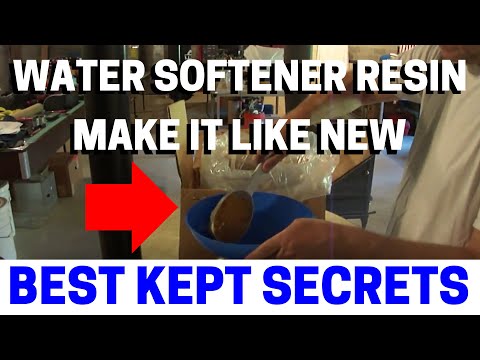What is a Water Softener?
A water softener is a system that removes minerals in water that make it ‘hard’, like Calcium and Magnesium. Hard water can cause a scaly buildup on your dishes, pipes, and appliances. It can also create soap scum, clogs, and corroded plumbing. Water softener repair is needed when mineral removal isn’t working at full capacity.
Soft water gives an extra boost to your detergents and makes your soap feel more slippery on your skin. Because of this, it’s recommended that you lower your soap/detergent usage after installing a water softener.

How Does a Water Softener Work?
A water softener removes hard minerals and introduces sodium ions instead. Sodium doesn’t interfere with soaps the same way calcium and magnesium do. This swap is done through an ion exchange.
During the ion exchange, positively charged cations (the stuff we want to remove from the water) are exchanged with a weaker charged molecule: sodium. Resin beads, an inorganic mineral that forms into tiny crystals, make this possible. Since the resin beads are negatively charged and can hold positive ions, they can pull out the strongly-charged calcium and magnesium ions as the hard water moves through the tank. Their charge is stronger, so they replace the sodium ions. A few sodium ions are then dispersed into the soft water that enters your faucet, shower, dishwasher, etc.

Water Softener Maintenance
Before we get into water softener repair, let’s cover a few maintenance tips that can help prevent the need for repairs in the first place.
- Clean the tank and resin bed to ensure your water softener lasts. Use pure salt with iron remover to avoid buildup caused by rock salt. Use Iron-Out to clean the parts in the control valve once a year.
- Avoid adding in more salt until the tank is almost completely empty. Then, refill with salt to the 2/3 mark. This ensures older salt doesn’t stick to the walls of the tank.
- Give your brine tank a deep scrub once a year. Pour the appropriate amount of water softener cleaner into the brine well.
- Check to make sure the end of the softener’s drain line is above the grate of the drain. Otherwise, sewage can leak into the softener.
- Use high-quality salt pellets (evaporated salt). Rock salt may be the cheapest, but it has more insoluble minerals.
- Keep an eye on the humidity level around your softener.
- Use salt products that are geared toward fixing certain issues (ie: high iron, rust stains, etc.).
- Clean the venturi valve a couple times each year. This piece can get clogged with sand, dirt and sediment, since it transfers brine from the brine tank to the resin tank. You’ll just need to unscrew the valve cover, take out a few parts and clean these parts in soapy water.
Water Softener Repair Issues
-
Salt Bridges
The salt won’t be able to mix with the water to produce brine if there are salt bridges in the way. These pesky bridges are caused by hard crust that forms in the brine tank. This crust separates the water and salt. If your water softener isn’t producing brine, the resin beads (softeners) can’t actually do what they’re meant to do.

Bridges are normally brought on by high levels of humidity, the wrong kind of salt and temperature changes in the area surrounding the softener. Keep an eye out for bridges when the temperatures start fluctuating! Test by prodding the top of the salt with a broom handle. You may have to use a little force to break up solidified salt.
-
Salt Mushing
Salt mushing occurs when dissolved salt recrystallizes and creates a sludge that settles at the bottom of the brine tank. This mush prevents the regeneration process, thereby halting the softening. Plus, this mushing blocks up the tank. You’ll be able to tell this is the issue if you try breaking up the salt bridge but can’t get it to dissolve. We’ll come in and drain the softener, remove the old salt and put it in a fresh batch of salt. Salt mushing is more serious than salt bridges. If you suspect your water softener may be suffering from salt mushing, contact an Anthony PHC technician right away.
-
Low Water Pressure
To figure out whether a drop in water pressure might be caused by your water softener, you should first call your city’s water department to see if they caused the drop in pressure. It may be a city-wide procedure. In the instance that your showerheads are also getting stuffed up, mineral deposits OR worn-out resins may be to blame.
You can identify which issue is to blame by removing the showerhead and running the water. If clean, clear water comes out, the mineral deposits were causing the problem. In that case, all you need to do is scrub the showerhead and clogged faucet screens. If there are sand-like particles in your water when you run it, the resins need to be replaced.

You’ll want to call in a professional to take care of the problem right away, since fragmented resins can harm plumbing fixtures and water heaters. This issue shouldn’t pop up often, since resins have a long life span (up to 20 years). However, chlorinated city water can lower this life span.
-
Too Much Salt
Salt overload occurs when you put in too much salt or keep replenishing the salt before it’s needed. This salt excess forms a dome in the brine tank. You’ll have to clear out all the salt from the tank to remedy the situation. To fix the problem, use a broom handle to break up the salt and remove the chunks. Then, clear out the sediment with a wet/dry vac and clean out the tank with soap. Rinse and repeat if necessary!

-
Brine Not Flowing
Breaks or wear in the brine line could be the culprit behind your faulty system. If there aren’t any breaks, flush the brine line out to cleanse the deposits. Check the user guide to make sure the line pressure is being regulated to the instructed amount, then examine the filter screen and injector (see below). It never hurts to clean the tank nozzle with a toothbrush or change the O ring on the resin tank, though we recommend the aid of a water softener repair professional.

Water Softener Troubleshooting Tips
While a lot of problems require water softener repair from a professional, there are a few things you can do to identify the problem and provide a quick fix. Keep in mind that you need to turn your water softener off before conducting any troubleshooting. This can be done by following the pipes to the point where they connect to the house. Switch the lever so it isn’t pointing to ‘soft’ and turn off the power to the unit.
- Clean the resin bed—it can get fouled from iron. Simply pour Iron-Out into the system and run your softener through a manual regeneration (the knob is located underneath the control valve). This flushes out the waste water. You can use other cleaning products as long as they have hydrogen hydrosulfite (ie: phosphoric or citric acid cleaners).
- Clean the resin tank injector—it can get plugged with sediment. Trigger the bypass valve to stop the flow of water, then run the softener through a manual regeneration. Remove the caps on both sides of the softener head next. Lastly, clean the injector and give the screen a good scrubbing.
- Make sure the control settings are accurate after a long power outage. You’ll notice the settings aren’t right if the water isn’t as soft as normal. The timer clock (see below) should be set so the resin tank is cleaned/recharged when water is not being used (ie: 3am).
- Conduct a hardness test to make sure the hardness setting is correct. A water softener dealer can take a look at your water hardness.
- If the system has stopped working altogether (motor won’t run), go check the fuse. It may have been tripped, or the cables may be faulty/incorrectly connected. Test the motor to make sure it hasn’t worn out.
- Check to see whether your water softener is out of salt. This is one of the most common problems and should be monitored monthly. If the salt is low, simply fill the tank until its 2/3 full with solar salt, rock salt or evaporated salt.
- Make sure the cycle generator is set to cycle for the appropriate amount of water and there are no leaks in other parts of your home. If there are leaks, your water calculations may be off.
Contact Us for Water Softener Repair!
For all your water softener repair needs, contact us! Our technicians receive 100 hours of training each year, average 15 years of experience and can be trusted with your house keys. We’ll give you an up-front estimate for any repairs and offer maintenance tips to preserve the longevity of your water softener. With a satisfaction guarantee, you’ve got nothing to lose!
You can learn more about how water softeners work and troubleshooting tips in our blog post.





